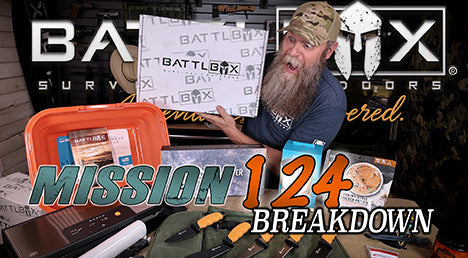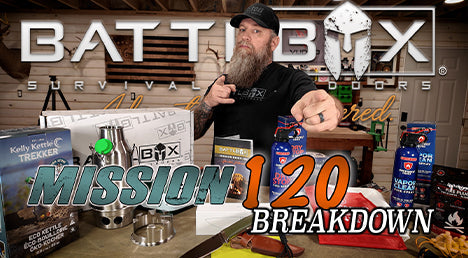Battlbox
How to Power an Off-Grid Cabin: A Comprehensive Guide
Table of Contents
- Introduction
- What Is Off-Grid Power?
- How Do I Get Power to My Off-Grid Cabin?
- How Many Watts Do You Need for Your Cabin?
- Solar Generator Kits for Off-Grid Cabins
- Conclusion
- FAQ
Introduction
Imagine sipping your morning coffee while surrounded by dense forests, the only sounds being the rustle of leaves and the gentle chirping of birds. An off-grid cabin offers you this serenity, but how do you ensure it has the power you need? As more people embrace sustainable living, the question of how to power an off-grid cabin has become increasingly relevant. The transition to off-grid power is not just about avoiding utility bills; it's about self-sufficiency, resilience, and a deeper connection to nature.
In this blog post, we will explore the various methods to power your off-grid cabin effectively. We'll delve into the advantages and disadvantages of different power sources, how to calculate your energy needs, and practical solutions to create a sustainable energy system. You'll also discover how Battlbox can help you equip your cabin with high-quality outdoor and survival gear to enhance your off-grid experience.
By the end of this post, you'll have a clear understanding of the energy options available for your off-grid cabin, as well as practical tips to implement them. Whether you're looking to install solar panels, consider wind power, or utilize a generator, this guide will provide you with the knowledge to make informed decisions.
What Is Off-Grid Power?
Off-grid power refers to a system that operates independently of the traditional electrical grid. This means generating and storing power on-site, typically using renewable resources like solar, wind, or hydroelectric energy. An off-grid system requires careful planning and management to ensure that power generation aligns with consumption.
Pros and Cons of Off-Grid Power
Before diving into the specifics, let’s weigh the benefits and challenges of off-grid power:
Pros:
- Self-Reliance: Off-grid systems free you from dependence on local utility providers. This independence often leads to significant savings on monthly energy bills.
- Resilience: Off-grid systems provide protection against power outages and grid failures, ensuring that you maintain power during emergencies.
- Eco-Friendly: Utilizing renewable energy sources reduces your carbon footprint, making it a sustainable lifestyle choice.
Cons:
- High Initial Costs: Installing an off-grid power system can be expensive, especially when factoring in solar panels, batteries, and inverters.
- Limited Energy Storage: Energy storage solutions like batteries have limits. Your system's efficiency will depend on the availability of sunlight or wind.
- Energy Management: You'll need to monitor and manage your energy usage carefully to ensure that your system meets your needs.
How Do I Get Power to My Off-Grid Cabin?
There are several methods to power your off-grid cabin, each with its own advantages and potential drawbacks. Let's examine the most common options:
1. Solar Power
Solar energy is a popular choice for off-grid cabins due to its accessibility and ease of use. Solar panels capture sunlight and convert it into electricity, which can then be stored in batteries for later use.
Components of a Solar Power System
- Solar Panels: The number of panels required depends on your energy needs and the amount of sunlight available in your area.
- Batteries: These store the energy produced during the day for use at night or during cloudy days. Lithium-ion batteries are often preferred for their efficiency and longevity.
- Inverter: Converts the DC power stored in batteries into AC power, which is used by most household appliances.
Advantages of Solar Power
- Renewable and Sustainable: Solar power relies on an abundant and renewable resource.
- Low Maintenance: Once installed, solar panels require minimal maintenance.
- Long-Term Savings: After the initial investment, solar power can significantly reduce your energy expenses.
2. Wind Power
Wind turbines harness wind energy to generate electricity. This option is most effective in areas with consistent wind patterns.
Components of a Wind Power System
- Wind Turbine: Converts wind energy into electrical energy. The size and type of turbine will depend on your energy needs and wind conditions.
- Batteries and Inverter: Similar to solar systems, wind power setups require batteries for storage and inverters to convert power.
Advantages of Wind Power
- Effective in Windy Areas: Wind power can be a reliable source of energy if your cabin is located in a consistently windy region.
- Complementary to Solar: Wind and solar can complement each other; when sun exposure is low, wind power may be available.
3. Micro-Hydro Power
If your cabin is near a flowing water source, micro-hydro power can be an efficient way to generate electricity.
Components of a Micro-Hydro System
- Turbine: Converts the energy from flowing water into electricity.
- Storage and Inverter: As with the other systems, batteries and inverters are necessary.
Advantages of Micro-Hydro Power
- Consistent Power Supply: Flowing water can provide a steady and reliable source of energy, often more stable than solar or wind.
- Low Operating Costs: Once installed, micro-hydro systems typically have lower operating costs.
4. Backup Generators
While renewable energy sources are ideal, a backup generator can provide additional reliability.
Types of Generators
- Gasoline Generators: Commonly available but may not be as efficient or eco-friendly.
- Propane Generators: Cleaner than gasoline and can be a good supplement to renewable sources.
Advantages of Generators
- Reliability: Provides power when renewable sources are insufficient.
- Flexibility: Can be used to power high-demand appliances during peak usage times.
How Many Watts Do You Need for Your Cabin?
Calculating your energy needs is crucial for designing a suitable off-grid power system. Start by listing all the appliances and devices you plan to use in your cabin, including:
- Lighting (LED bulbs)
- Refrigeration (solar fridge)
- Heating (electric heaters)
- Electronics (laptops, phones, etc.)
- Kitchen appliances (microwaves, coffee makers)
Estimating Power Usage
- Identify Appliance Ratings: Check the wattage ratings on your appliances, usually found on the device or in the manual.
- Calculate Daily Usage: Multiply each appliance's wattage by the number of hours you plan to use it daily.
- Total Your Needs: Add the total wattage for all devices to determine your daily power requirement.
For example, if you plan to use the following:
- LED lights (10 bulbs at 10 watts each for 5 hours): 10 x 10 x 5 = 500 watts
- Refrigerator (100 watts for 24 hours): 100 x 24 = 2400 watts
- Laptop (50 watts for 3 hours): 50 x 3 = 150 watts
Your total would be 500 + 2400 + 150 = 3050 watts per day.
Recommended Wattage for Off-Grid Cabins
A well-run off-grid cabin typically requires between 5,000 to 7,000 watts of power daily to manage various needs effectively. This estimate allows for a comfortable living experience, accommodating both essential and luxury appliances.
Solar Generator Kits for Off-Grid Cabins
To simplify the setup process, consider investing in a solar generator kit. These kits typically include solar panels, a generator, and batteries, allowing for efficient energy generation and storage. Here are three highly recommended solar generator kits:
1. BLUETTI AC200MAX
- Power Output: 2,200 watts (peak 4,800 watts)
- Battery Capacity: 2,048Wh (expandable to 6,144Wh with additional B230 units)
- Solar Input: Max 900W for solar intake
- Features: Seven recharging methods, ideal for larger cabins with higher power demands.
2. BLUETTI AC300
- Power Output: 3,000 watts (surge 6,000 watts)
- Battery Capacity: 3,072Wh (expandable to 12,288Wh)
- Charging Options: Multiple modes including solar, AC, and generator.
- Ideal For: Large cabins requiring substantial power.
3. EP500Pro
- Power Output: 3,000 watts
- Battery Capacity: 5,120Wh
- Features: App-based remote control, versatile recharging, and a smart touchscreen.
- Ideal For: Those needing a portable and powerful off-grid solution.
Conclusion
Powering an off-grid cabin is an exciting venture that opens the door to self-sufficiency and a deeper connection with nature. By understanding the various power sources—solar, wind, micro-hydro, and generators—you can create a tailored energy system that meets your specific needs. Calculating your energy requirements will guide you in selecting the appropriate equipment, ensuring your off-grid lifestyle is both sustainable and comfortable.
At Battlbox, we believe in empowering outdoor enthusiasts with the right gear for every adventure. Whether you're embarking on the journey of building an off-grid cabin or simply looking for high-quality outdoor equipment, our subscription services and shop provide a wealth of resources tailored to your needs. Explore our offerings today to enhance your off-grid experience.
For those ready to take the plunge, our subscription services can equip you with essential gear every month. Discover more about our Battlbox Subscription Services and explore our extensive Battlbox Shop to find the perfect gear for your off-grid cabin.
Embrace the freedom and adventure of off-grid living and take control of your energy future!
FAQ
What is the best power source for an off-grid cabin?
Solar power is often the most practical and accessible option for off-grid cabins due to its renewability, ease of installation, and low maintenance. However, in windy areas, wind turbines can also be effective, and micro-hydro power is ideal for locations near flowing water.
How much does it cost to set up an off-grid power system?
The cost varies significantly depending on the size of the system and the components used. A typical solar power setup can range from a few thousand dollars to over $20,000, depending on your energy needs and the quality of equipment selected.
Can I use a backup generator with my off-grid system?
Yes, a backup generator can provide additional reliability, especially during periods of low sunlight or wind. It's a good idea to have a generator as a supplementary power source.
How do I maintain my off-grid power system?
Regular maintenance is crucial for ensuring the longevity and efficiency of your system. This includes cleaning solar panels, checking battery levels, and ensuring all connections are secure. Consult the manufacturer's guidelines for specific maintenance requirements.
Is it legal to power an off-grid cabin?
In most regions, it is legal to power an off-grid cabin. However, you should check local regulations and zoning laws to ensure compliance with any requirements related to energy systems, especially if you plan to install larger solar or wind setups.
Share on:

















